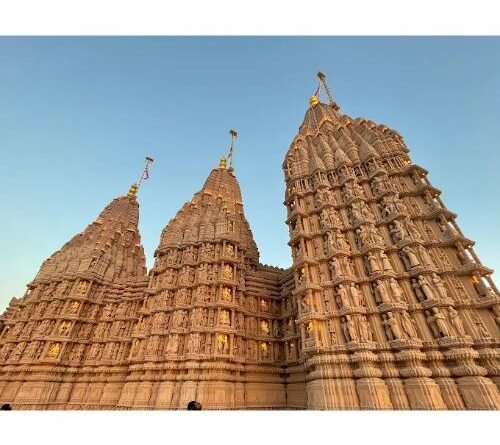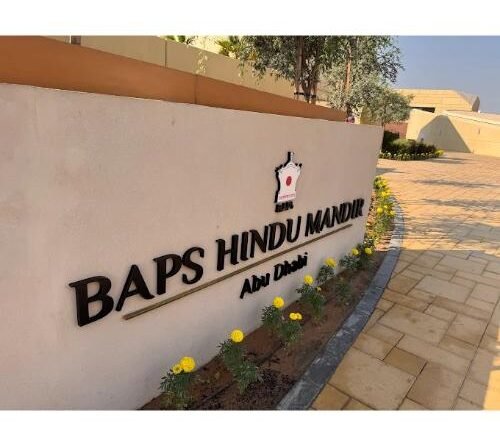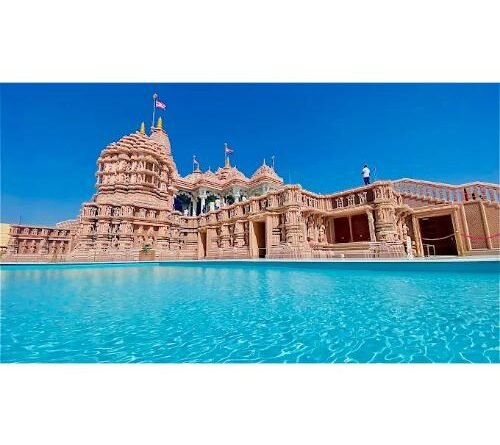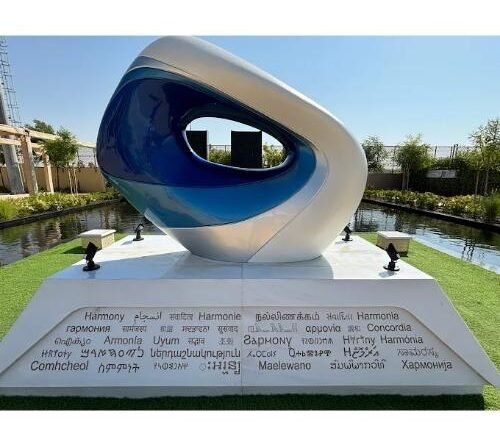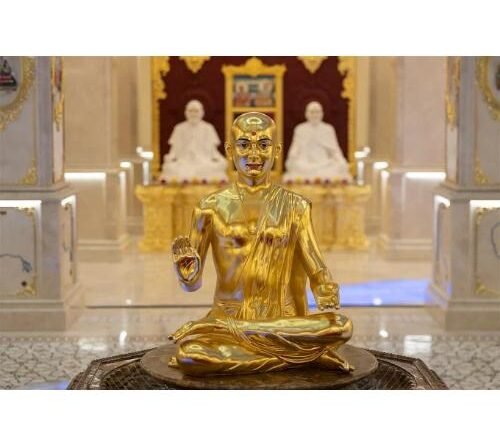BAPS Hindu Mandir Abu Dhabi
BAPS Hindu Mandir Abu Dhabi is a traditional Hindu temple built by the BAPS Swaminarayan Sanstha in Abu Dhabi, United Arab Emirates (UAE). Inspired by Pramukh Swami Maharaj (1921–2016) and consecrated by Mahant Swami Maharaj on 14 February 2024, this is the first traditional Hindu mandir in Abu Dhabi. In 1997, Pramukh Swami Maharaj envisioned a mandir in Abu Dhabi. In August 2015, the UAE government announced they would provide the land for the mandir. Sheikh Mohammed bin Zayed Al Nahyan, the Crown Prince of Abu Dhabi, gifted 27 acres of land for the mandir.
In September 2019 the mandir gained legal status, and in December 2019, the construction commenced. The mandir is constructed from pink sandstone from northern Rajasthan and marble from Italy. The mandir stands 108 feet tall, 262 feet in length and 180 feet in width. This is the first Hindu stone mandir to undergo complete digital modeling and seismic simulations during the construction process.
The mandir is a symbol of interfaith harmony, representing the UAE’s and India’s good relations to foster understanding, acceptance, and unity among people of different religious backgrounds. Accordingly, the mandir carvings not only incorporate stories from the Ramayana, Shiva Purana, Bhagavatam, Mahabharata, and the lives of Hindu figures, but also stories from Arabian, Egyptian, Mesopotamian, Native American, and other civilizations. The mandir complex includes the traditional Hindu mandir, a visitor centre, prayer halls, exhibitions, learning areas, etc.
The mandir’s middle shrine houses the marble murtis (transl. sacred images) of Swaminarayan and Gunatitanand Swami, who are collectively worshiped as Akshar-Purushottam Maharaj. Swaminarayan is the founder of the Swaminarayan Sampradaya and is revered as Purushottam (God) and Gunatitanand Swami is the first spiritual successor of Swaminarayan and is revered as Akshar.
The second shrine houses the marble murtis of Krishna, an avatar of Vishnu, with his consort, Radha. Radha-Krishna are a central deity pair worshiped in Vaishnavism. The third shrine houses the marble murtis of Rama with his consort Sita, his brother Lakshmana, and Rama’s dedicated devotee Hanuman. Rama is worshiped as an avatar of Vishnu. The marble murtis of Shiva, a principal deity in Hindu traditions, with his consort Parvati, goddess of power and energy, and two sons, Ganesha and Kartikeya, are housed in the fourth shrine.
The fifth shrine houses the black granite murtis of Srinivasa, also known as Venkateshwara, an incarnation of Vishnu, and his consort Padmavati who is an incarnation of Lakshmi, the goddess of wealth. These murtis were crafted by expert artisans from the Tirupati temple in Andhra Pradesh. The murtis of Jagannath, a form of Krishna, accompanied by his siblings Subhadra and Balabhadra are housed in the sixth shrine. These murtis were made under the supervision of the king of Jagannathpuri in Odisha.
The seventh shrine is dedicated to the deity Ayyappan. His murti is made from panchaloha (traditional five-metal alloy) and was designed by 15 artisans from Kerala. The murti sits on a pedestal and is four feet in height. The murti is also accompanied by a model of the 18 holy steps of the Sabarimala Ayyappa Temple in Kerala.
Pramukh Swami Maharaj visited the Middle East in 1997 and envisioned a mandir in Abu Dhabi. On the evening of 5 April 1997, Pramukh Swami Maharaj visited a desert in Sharjah where he stated that a mandir in Abu Dhabi would bring “countries, cultures, and religions closer together.”
In August 2015, the UAE government announced the decision to provide land for building a Hindu mandir in Abu Dhabi. Sheikh Mohammed bin Zayed Al Nahyan, the Crown Prince of Abu Dhabi and Deputy Supreme Commander of the UAE Armed Forces, gifted the land for the mandir. Indian Prime Minister Narendra Modi welcomed the development, stating, “I am confident that it will be a symbol of peace, piety, harmony, and inclusiveness that are inherent to the faith of Islam. I thank the UAE leadership for this landmark decision.” Sheikh Mohammad Bin Zayed Al Nahyan gifted 13.5 acres for the temple and 13.5 acres for parking. Navdeep Suri, the former Indian ambassador to the UAE, noted that the BAPS mandir in Abu Dhabi was considered important by both Indian and UAE leaders, ranking among their top priorities.
On 10 February 2018, BAPS representatives met Sheikh Mohammed and the Indian Prime Minister Narendra Modi in the Presidential Palace. A memorandum of understanding was signed by India and the UAE in the presence of the entire royal family and over 250 local leaders. Prime Minister Modi expressed that the mandir “will be a holy place where humanity and harmony will unite”. The first stone consecration for the mandir took place on 11 February 2018.
On 20 April 2019, in the presence of Mahant Swami Maharaj, the spiritual leader of BAPS, the foundation stone-laying ceremony (transl. shilanyas vidhi) was performed in the presence of guests and officials from India and the UAE.
The Hindu Mandir in Abu Dhabi was a deeply spiritual and serene experience. The architectural brilliance is truly awe-inspiring—featuring intricately hand-carved stonework, majestic spires, and a beautifully balanced design that harmoniously blends tradition with modern craftsmanship.
Constructed using time-honored techniques, the temple stands as a remarkable testament to India’s rich spiritual and cultural heritage. The atmosphere is peaceful, the staff are gracious and welcoming, and the overall ambience radiates positivity and unity.
This sacred space is a must-visit for anyone seeking inner peace, cultural insight, and a deeper sense of connection.











